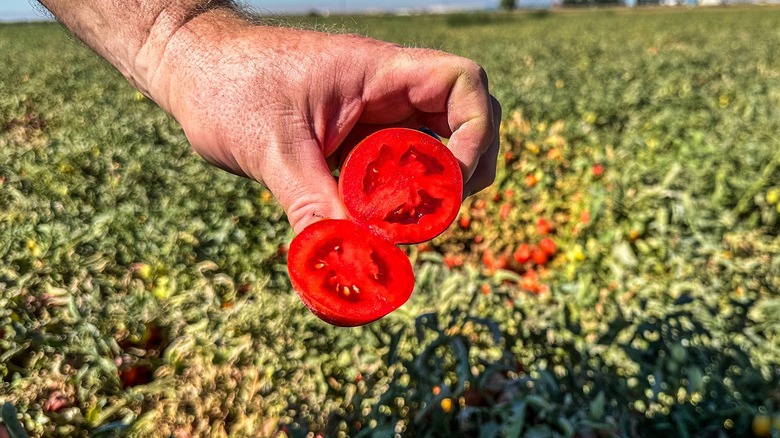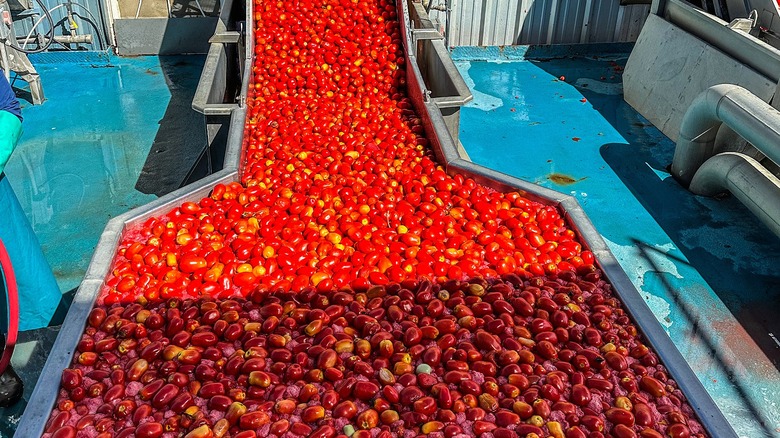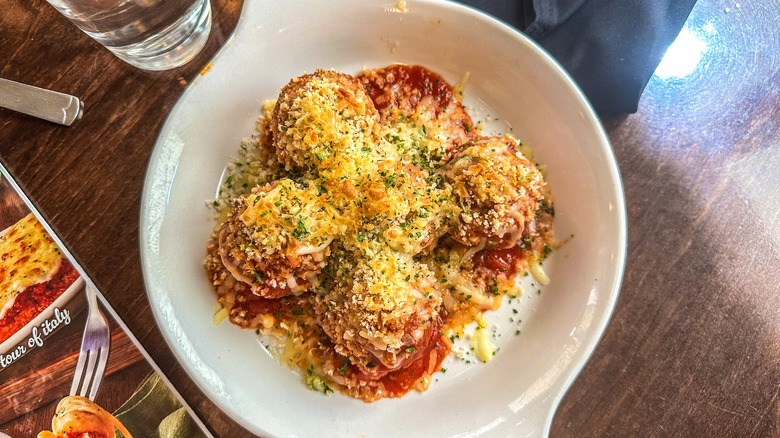We Got An Inside Look At How Olive Garden Gets Its Marinara From Farm To Table
No matter how often you eat at a chain restaurant, whether once a week or once a year, have you ever considered how your food got there? Not just the cooking process, but the journey of the ingredients to your plate?
At Olive Garden, a nationwide restaurant chain with over 900 locations, it can be easy to assume you know the journey of any number of its menu staples, most notably the sauces, but before you imagine cans and jars of premade marinara sauce being poured directly onto your plate, take a moment. While other restaurants at this scale may work this way, Olive Garden's sauce process has a little more to it. In fact, a lot more to it.
I had the opportunity to witness Olive Garden's tomato harvesting process in Fresno, California, during the first week of September. I got to see every step, from the harvest and processing to the preparation of the marinara sauce at a local Olive Garden restaurant. The entire process, while technical, is an example of the lengths Olive Garden will go to deliver a quality product. It's a team of experts — a family of experts, you could say — from farmers and factory workers to scientists and chefs. At the end of the experience and with a newfound appreciation for farm-to-table cuisine, it was hard for me not to feel like when I was there, I was part of the family, too.
California's Central Valley is home to Olive Garden's tomatoes
It's 5:30 a.m. in Fresno, and Robert Krahn, senior manager of field operations for Neil Jones Food Company, is busy already. It's tomato harvesting season for Olive Garden, and while he's able to take a few hours to rest, the harvest itself is a 24/7 operation. Throughout the day, he's checking on truckloads, deliveries, and inventory. In between meetings with growers and industry personnel, he's monitoring the progress for thousands of acres of tomatoes, which, about nine months ago, were nothing more than seeds in a greenhouse.
The heat and intense sunshine in the Central Valley are ideal for the tomato crop, according to Krahn and his team of growers. Environmental factors are key, and tomatoes thrive in hot climates. "Mother nature has the ultimate say," noted Frank Costamagna, grower at OPC Farms, Inc. "The hotter the temperature, higher the brix, the sweeter the tomato. You always want that fresh tomato flavor, and that's sunshine."
Olive Garden's sun-soaked tomatoes, which are a mix of varieties and colors to account for sugar content, acidity, and viscosity, are planted between February and May and harvested the last week of August into the first week of September. The variety and acres planted are based entirely on the needs of Olive Garden year over year, ensuring a consistent crop each time.
From field to factory, the harvest process takes four to six hours
Technology has done a lot for the farming industry, and this tomato harvest is no exception. The tomato harvesters can pick 100 tons of fruit an hour. They're able to sort through the tomatoes using an electronic eye that's looking for red, meaning any dirt, sticks, or non-tomato objects that are picked up will get kicked off and fed back into the soil. Each harvester traverses the fields, row by row, and dumps the fruit into trucks, which drive just across the road to the Neil Jones Food Company factory.
Over the next four to six hours, the process continues. Each tomato is rinsed thoroughly and electronically inspected for color, using the same technology from the harvesting machines. "Although this technology is simple, it's effective," said Michael Dunn, director of product development for Neil Jones Food Company. After that thorough cleaning, each tomato is steamed to remove the peel and any other impurities on the skin that may have been missed during those first two rinses.
While some of that peel is finely chopped and used in the tomato puree for the sauce base, the rest is either used for cattle feed or tilled back into the field to feed the soil. Once blanched, steamed, and (almost) entirely peeled, the tomatoes are randomly cut and diced for a Neapolitan, rustic look that taps into that homestyle feeling.
The laboratory is the home of tomato quality assurance
The laboratory at the Neil Jones Food Company is where labor meets science. The lab team is doing analysis of all kinds: checking sugar and pH levels, tests to establish specific parameters from each client, and whatever else needed to see the bigger picture. For Olive Garden's purposes, the bigger picture is ensuring that the tomato product, which, at this point, is in the early stages of puree and sauce, is of the right quality and consistency. Color meters, consistometers to measure viscosity, and titrators to measure the split between acid and salt are all used throughout the day to, above all else, ensure the product is to the specifications set forth by the culinary team at Olive Garden. Plus, the lab has checks in place that will send up a red flag if something isn't quite right.
"Unlike some other processors, we check all of our batches, but the question comes up, 'You run so much stuff, how can you check it all?'" said Michael Dunn. "We can't check 100% of everything ... but we can catch an issue before it happens. As simple as it all sounds, it's critical. We've eliminated as much human error as we can."
As batches are fine-tuned and adjusted, the team is looking for a certain something: A cooked, balanced flavor, with a texture that isn't too thick or too watery. A product that's just right.
The tomatoes are cooked down and packed to ship to over 900 Olive Garden locations
While the sauces at Olive Garden are made fresh every day, they do spend time being cooked and flavored before reaching the kitchen. At the factory, the tomato sauce is transferred to massive steel pots, cooked and lightly seasoned, and then packed into bags. It's during this time that the processors can continue to test pH levels to ensure everything is in perfect balance. Both the marinara sauce base and the meat sauce base are perfected at this point (the tomato base for the meat sauce gets beef base and additional seasonings added to it for a more concentrated, meaty flavor), then bagged and vacuum sealed.
"What's unique about our process ... we cook it and then put it in the bag. It's effectively flash pasteurizing," said Michael Dunn. "We heat it up, it goes into the bag hot, it stays hot for a number of minutes to sterilize it, and then it's cooled down rapidly." The bags are vacuum sealed to ensure freshness, stored safely in the facility, and distributed throughout the year.
While there are a lot of steps that have taken place up to this point, it's a shorter process than you might think. From the steam peeler, through the dicer, and into the bag, it's all happening in a matter of minutes. That's why, according to Dunn, the team can claim that from farm to bag, the process is about four hours.
Once at Olive Garden, the tomato sauce is used to make the marinara sauce
The heaviest lift is done during the harvest, but there's just as much work to be done once that tomato sauce base reaches the Olive Garden kitchen. On a factory level, the base has been heated and lightly seasoned, which is already helping to get the sauce to that right flavor and texture, but it's in the kitchen that science gives way to culinary mastery. Olive Garden chefs add in a marinara battuto, essentially a concentrated flavor package made with peppers, garlic, onions, basil, rosemary, and plenty of spices, to turn the base from tomatoes in sauce to marinara sauce.
"This little pouch is everything under the sun," notes Terrence Tookes, executive chef for Olive Garden. "It's highly concentrated. All our salt, sugar, everything is in this pouch. It keeps things super consistent across our 920 restaurants."
The marinara recipe, even at this large of a scale, is an exercise in simplicity: Heat oil in a pot, add the battuto, and cook for three minutes to allow the herbs and spices to really bloom. The tomato base is then added in, whisked constantly as it's heated to 185 degrees Fahrenheit, and then simmered for 20 minutes to allow the flavors to continue to develop. "There's no Italian kitchen where sauces aren't simmered," notes chef Tookes. "We found that after the 20-minute period, the flavors are at their best. You can taste the difference in those 20 minutes."
The 'why' behind Olive Garden's sauce process
It may have started as nothing more than seeds in a greenhouse, but the tomato itself — from the harvest to the chef — is what makes the marinara sauce at Olive Garden such a touchpoint of the menu as a whole. The entire journey is an example of taking a process that is done in kitchens around the world and scaling it up to feed millions of people at once.
"Rarely do we stop to think about the journey," notes executive chef Terrence Tookes as he whisks up a large pot of marinara sauce for the restaurant. "We know what the end result is gonna be ... there's a lot of intention that goes into everything that hits the table. From conception to consumption, all the care and love that goes into the final product is really important to deliver."
By mid-October, at the end of the tomato harvest season, Robert Krahn gets a chance to take a breath, regroup, and ultimately start planning for the next growing season. New tomato varieties are to be considered, as well as repairs on machinery and what fields need to be rotated and re-planted to keep the soil healthy and ready for the next tomato crop. While Olive Garden guests are enjoying the freshly made sauce, Krahn is looking to next year's harvest already.
"We start planning for next year now," said Krahn with a bit of a laugh. "Growers make their crop plan early. It's constant. We're always looking ahead."






